Impact of relations between employees and customers to the customers’ positive word-ofmouth in real estate industry
The study aims to explore and measure the relationship between employees and customers
impacting positively to the word-of-mouth of customers who bought house from the real estate
developers in Ho Chi Minh City. The study was based on survey data from 300 customers who
bought house from the real estate developers in Ho Chi Minh City and using techniques of
Cronbach Alpha analysis and Exploratory Factor Analysis (EFA). The study shows 4 factors of
customer relationship affecting positively customers’ word-of-mouth, including: (1) Familiarity;
(2) Personal connection; (3) Care; (4) Trust. From the findings, the study suggests some policy
implications to the real estate developers to improve the customers’ positive word-of-mouth
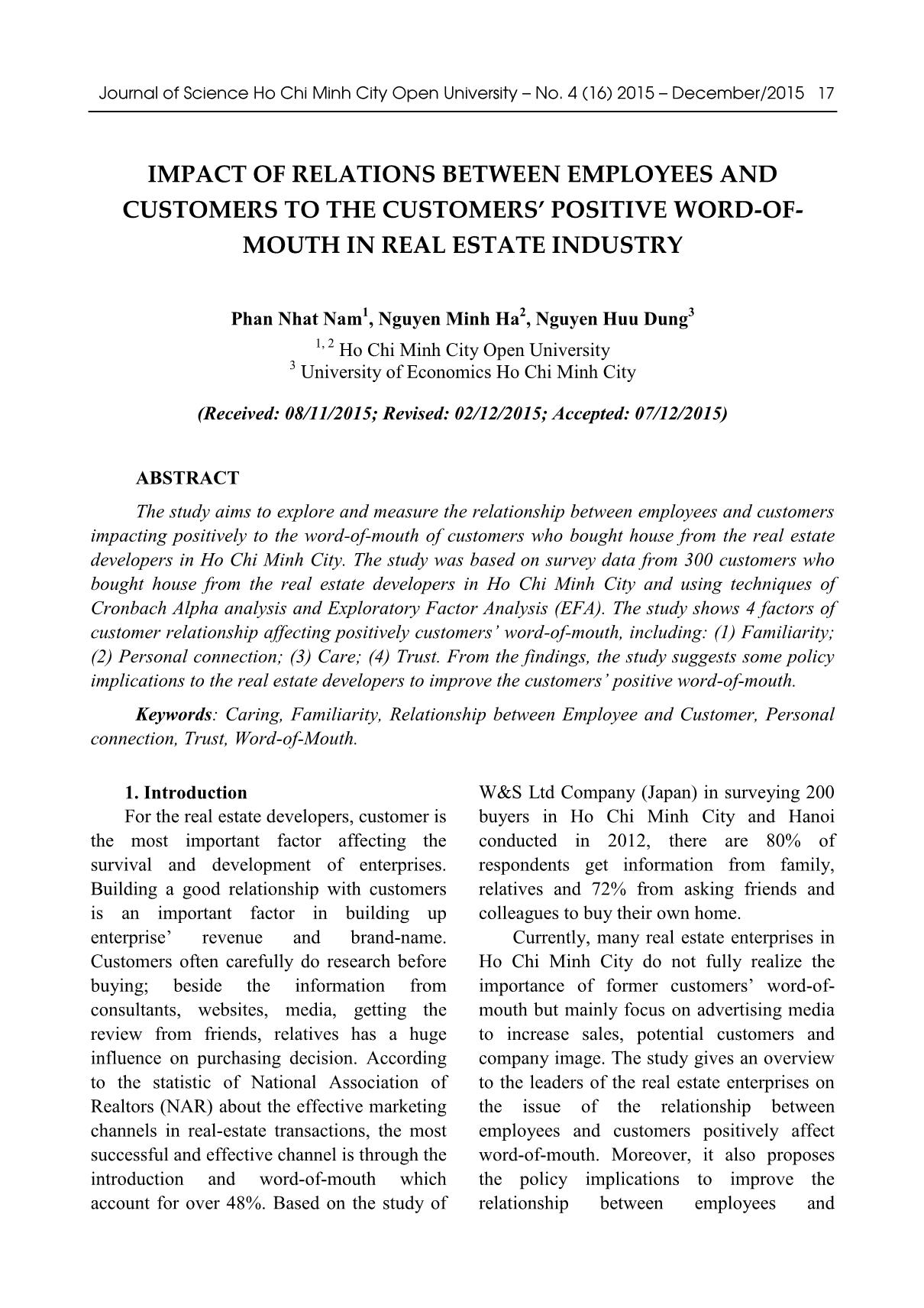
Trang 1
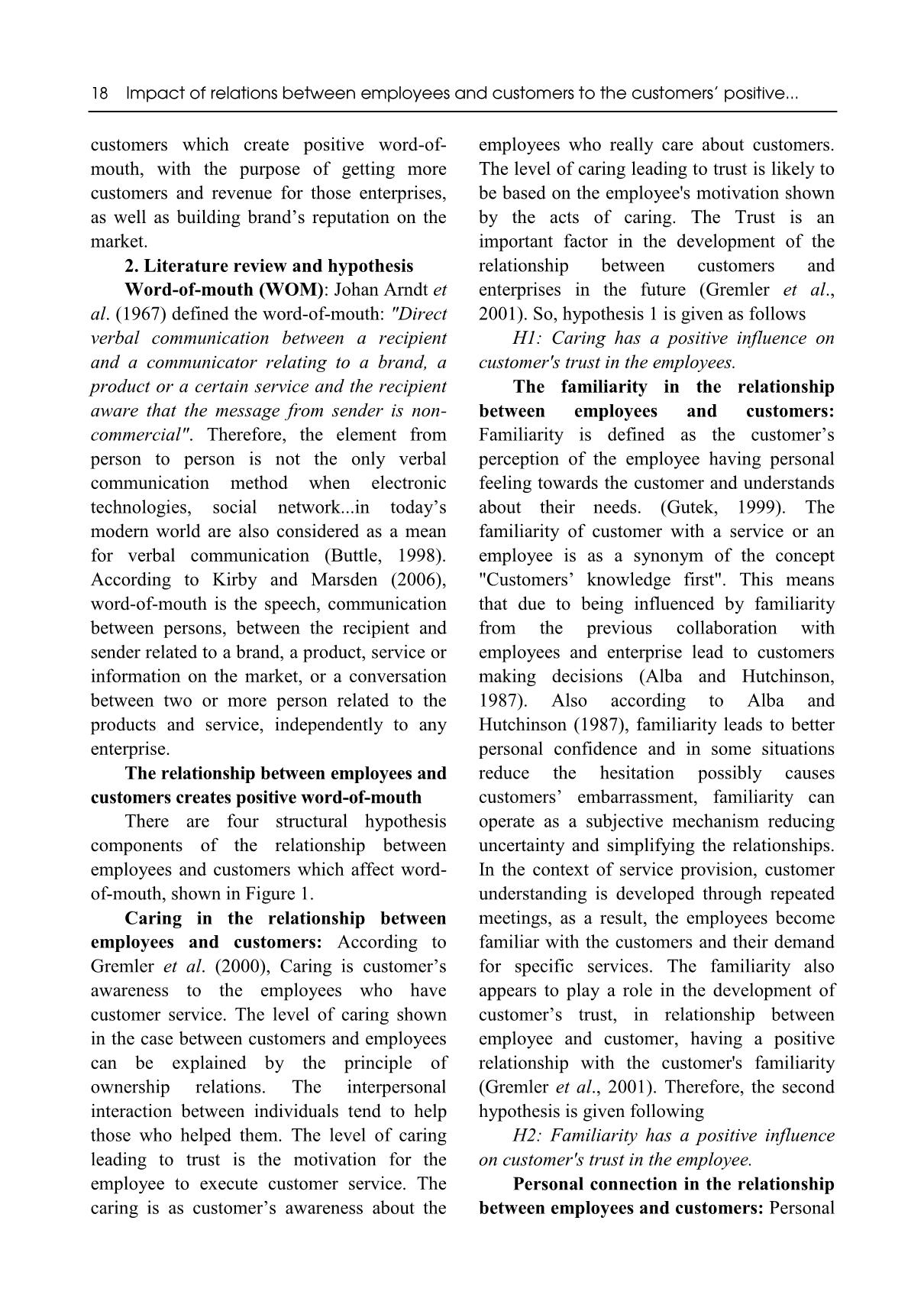
Trang 2
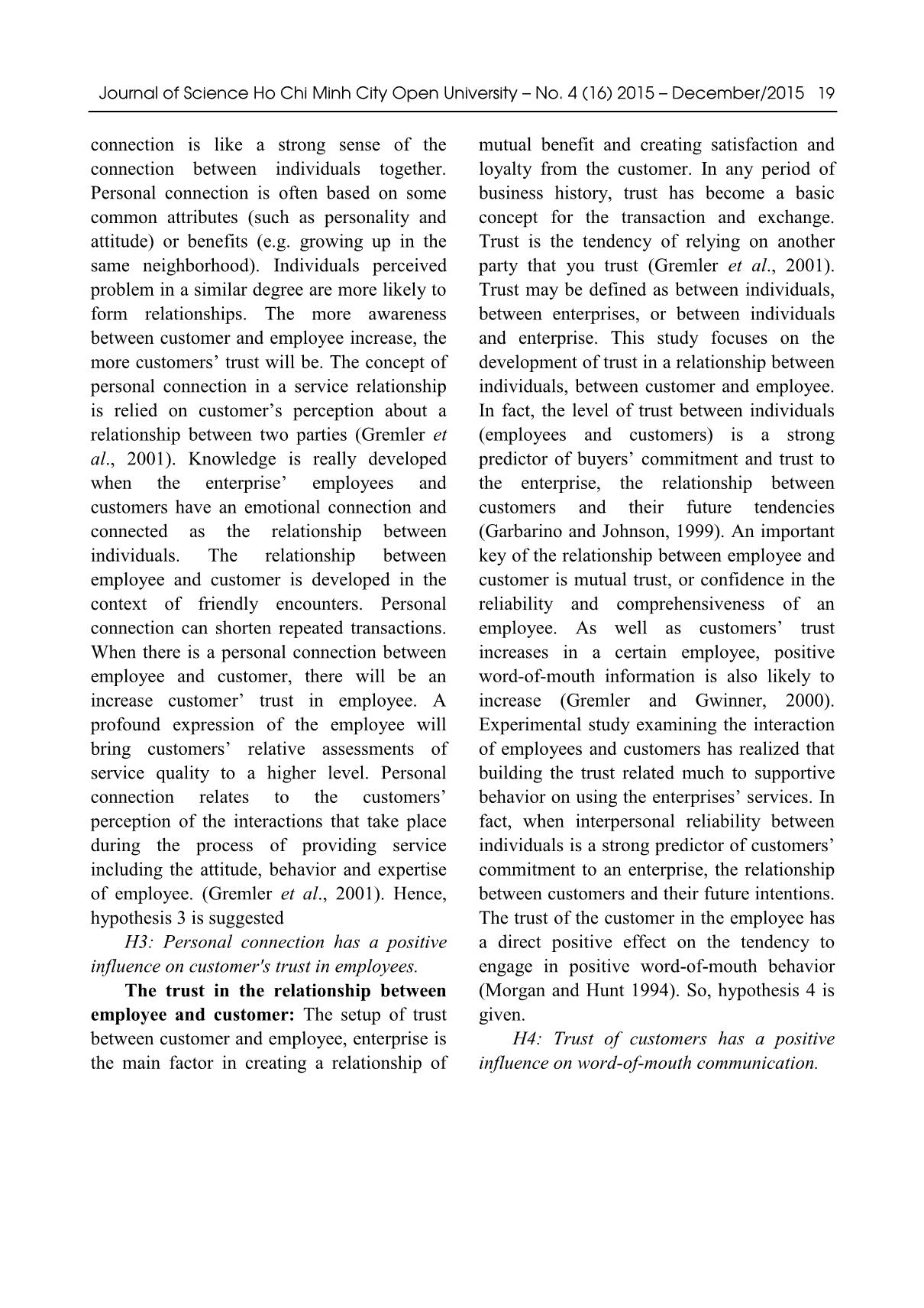
Trang 3
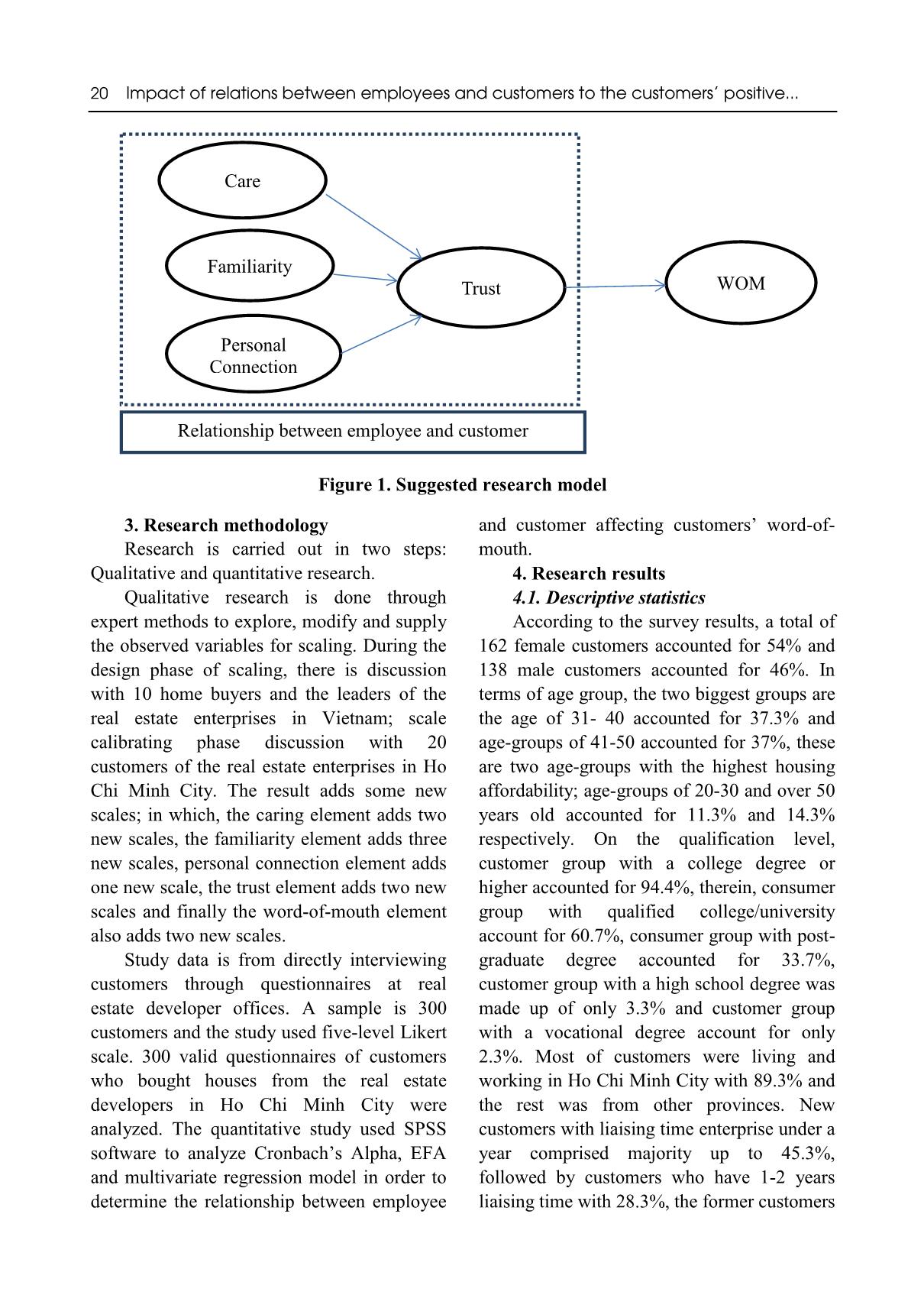
Trang 4
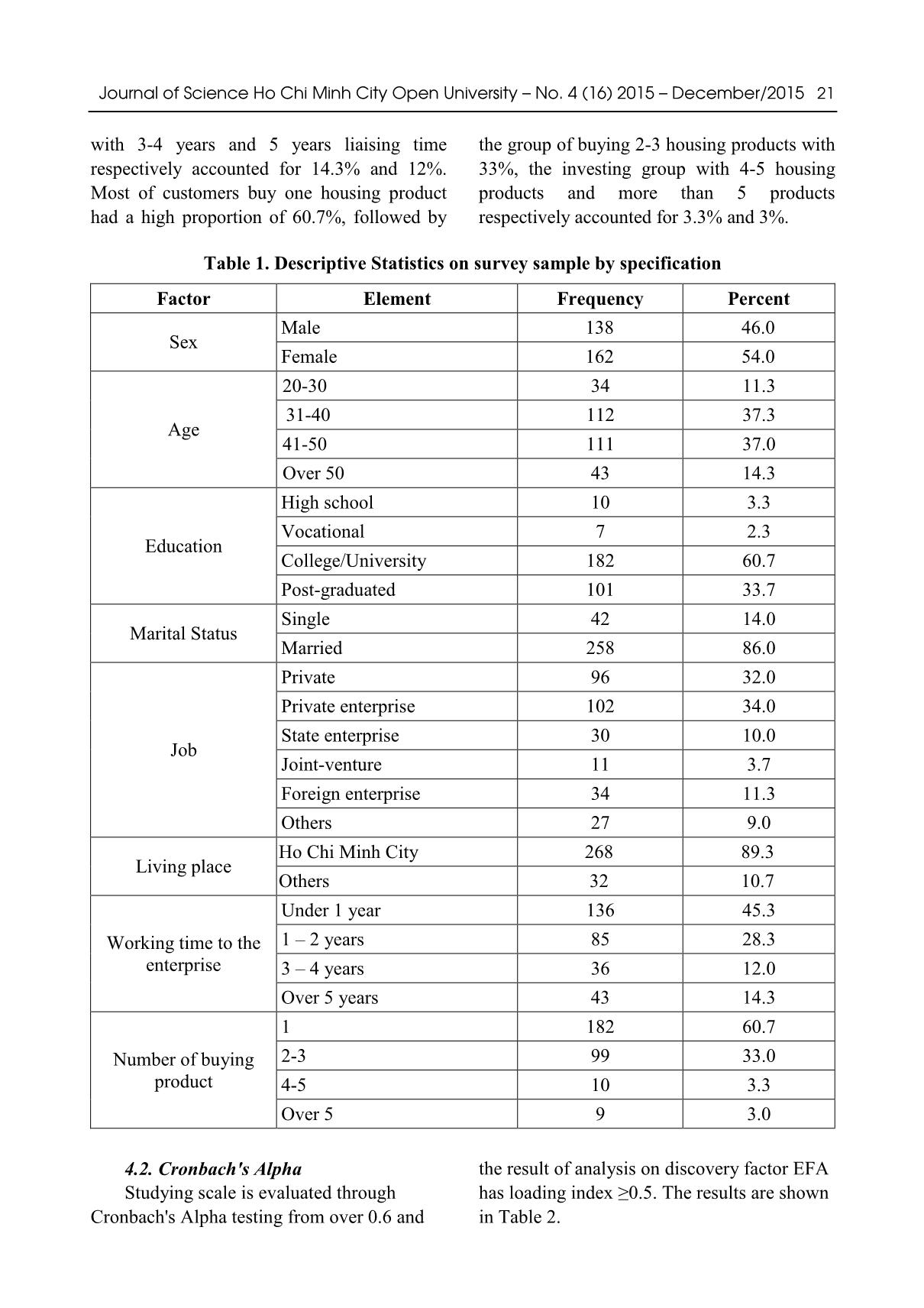
Trang 5
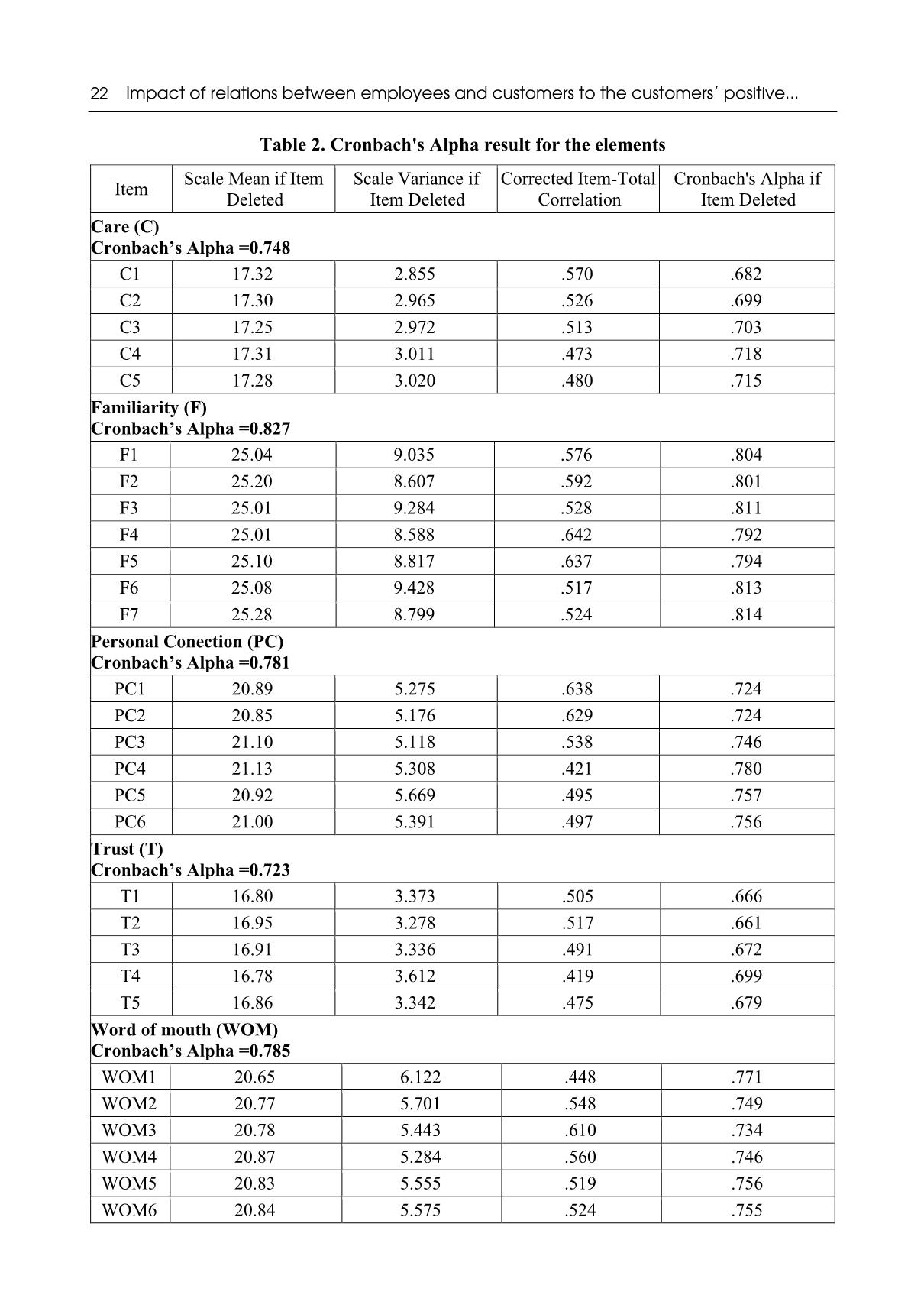
Trang 6
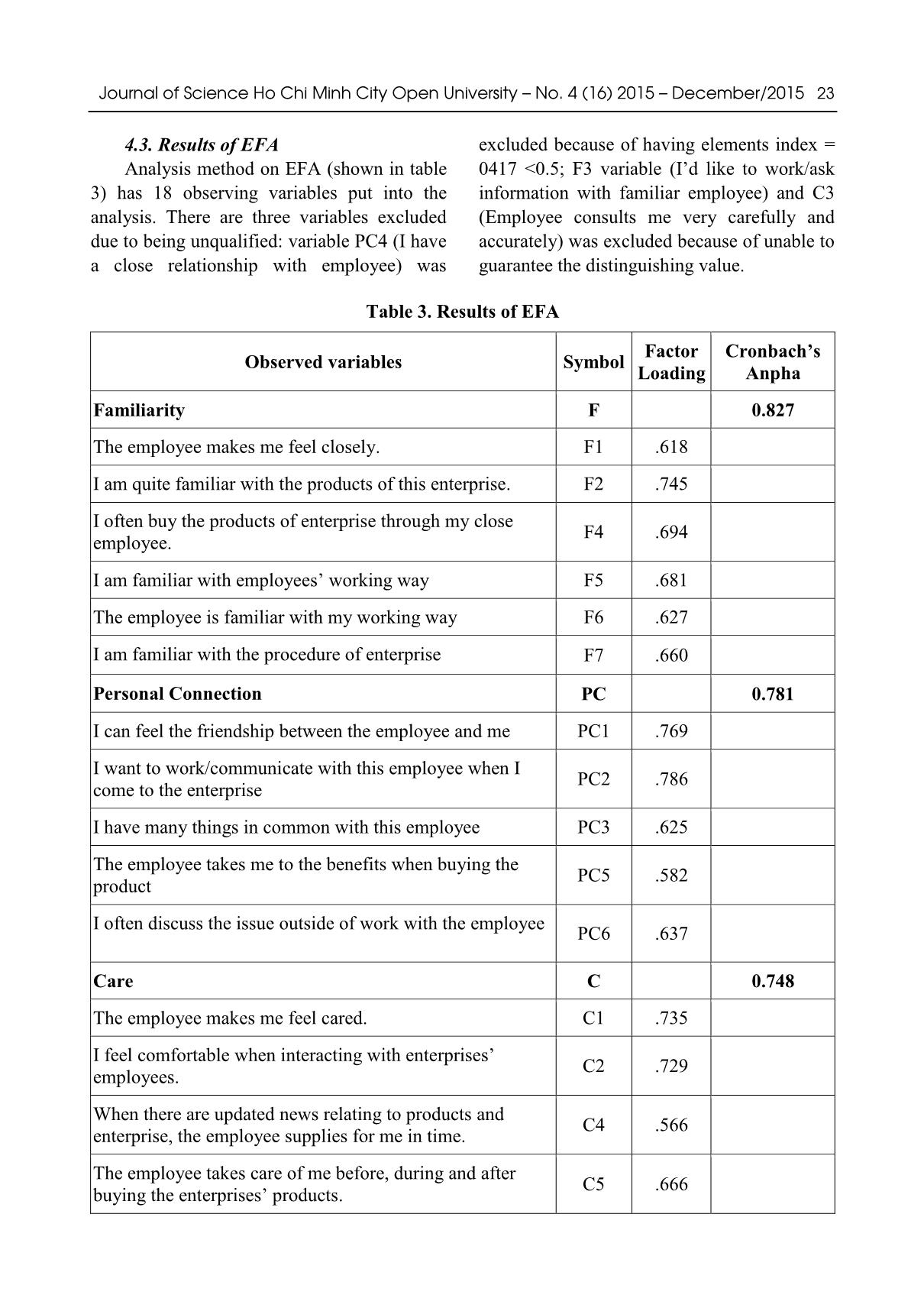
Trang 7
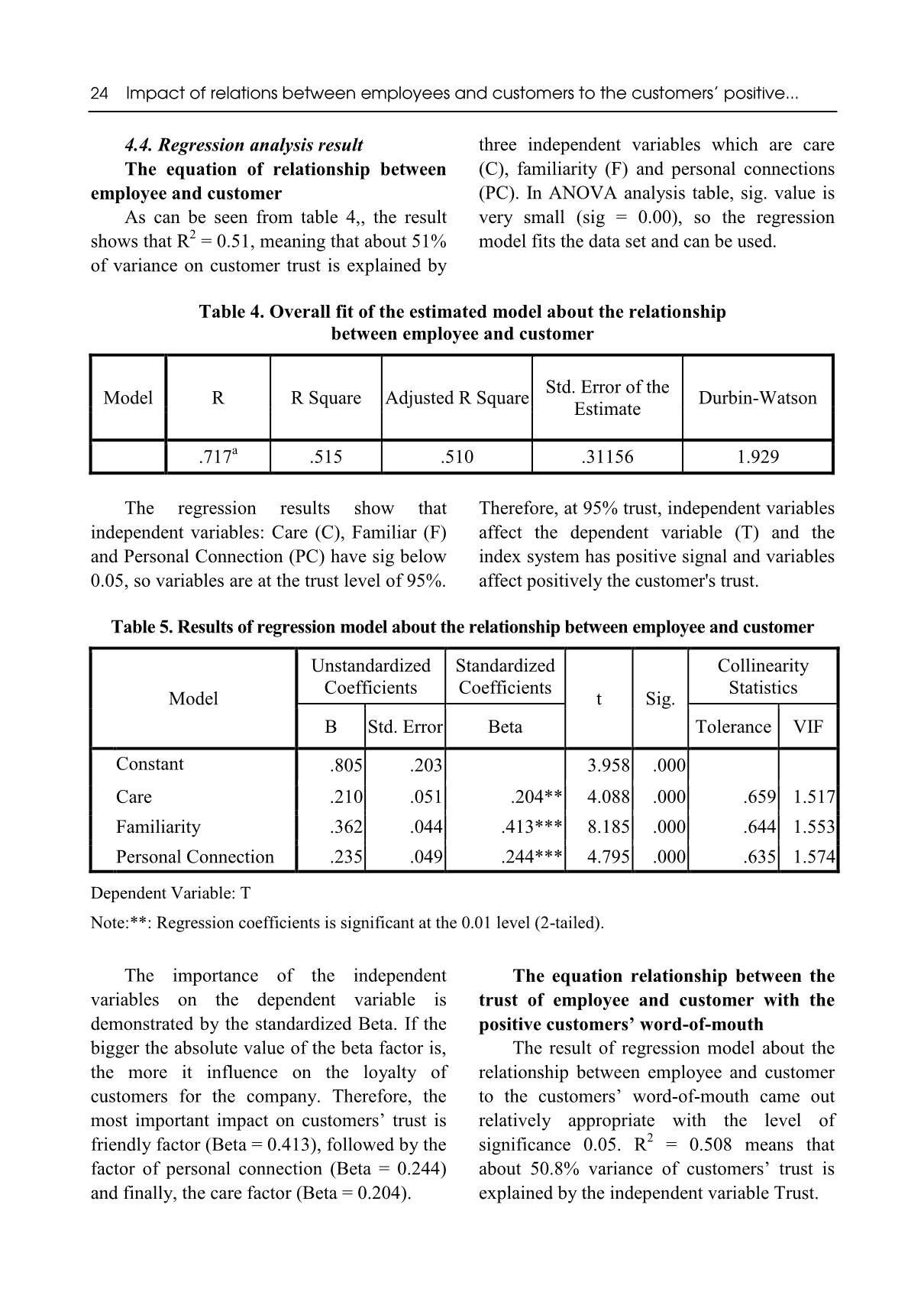
Trang 8
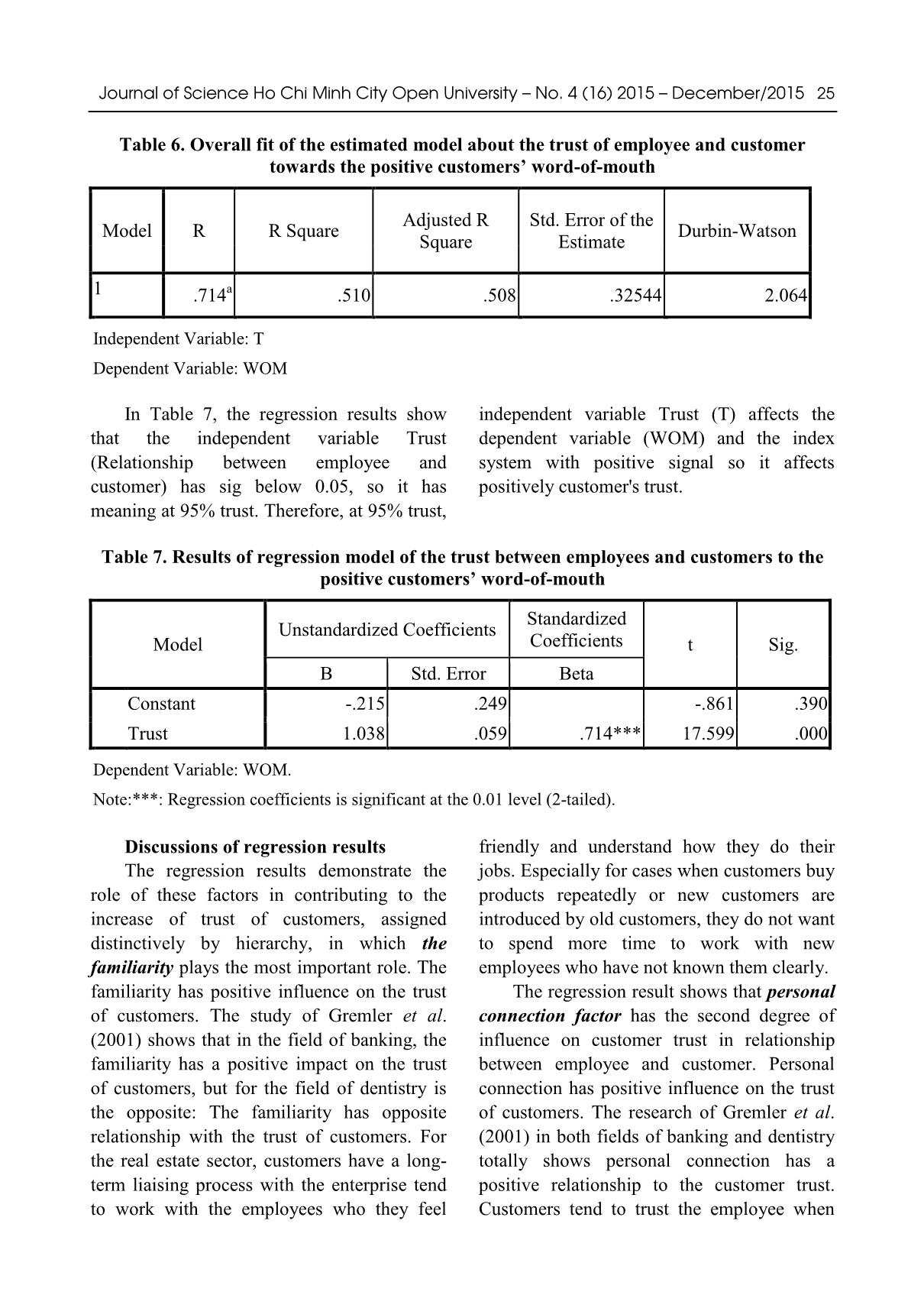
Trang 9
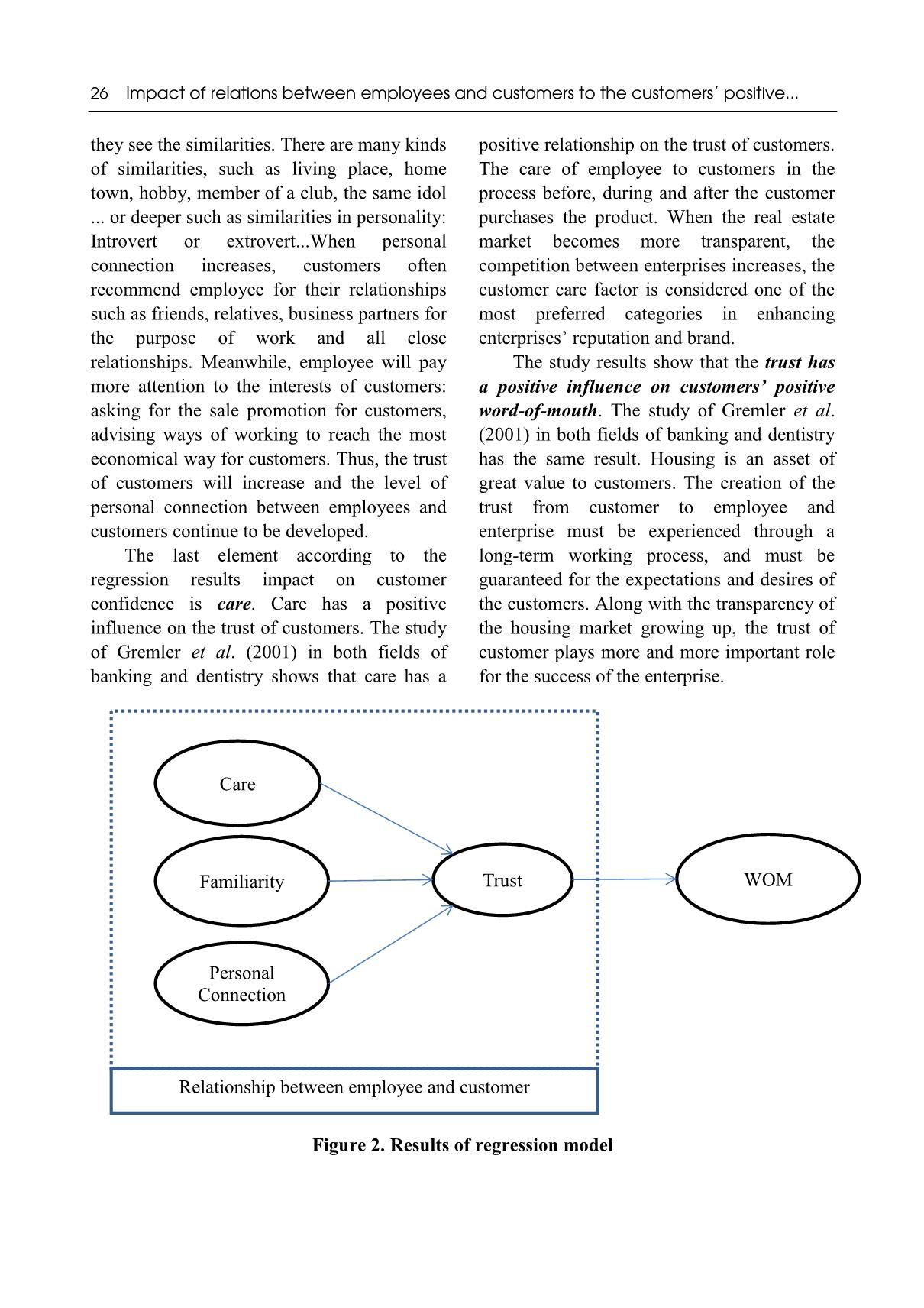
Trang 10
Tải về để xem bản đầy đủ
Tóm tắt nội dung tài liệu: Impact of relations between employees and customers to the customers’ positive word-ofmouth in real estate industry
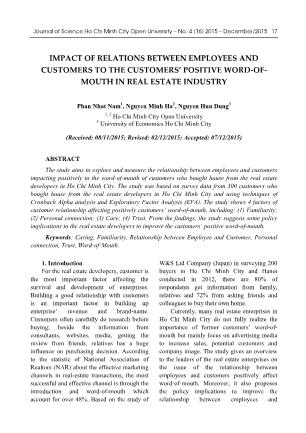
Journal of Science Ho Chi Minh City Open University – No. 4 (16) 2015 – December/2015 17 IMPACT OF RELATIONS BETWEEN EMPLOYEES AND CUSTOMERS TO THE CUSTOMERS’ POSITIVE WORD-OF- MOUTH IN REAL ESTATE INDUSTRY Phan Nhat Nam 1 , Nguyen Minh Ha 2 , Nguyen Huu Dung 3 1, 2 Ho Chi Minh City Open University 3 University of Economics Ho Chi Minh City (Received: 08/11/2015; Revised: 02/12/2015; Accepted: 07/12/2015) ABSTRACT The study aims to explore and measure the relationship between employees and customers impacting positively to the word-of-mouth of customers who bought house from the real estate developers in Ho Chi Minh City. The study was based on survey data from 300 customers who bought house from the real estate developers in Ho Chi Minh City and using techniques of Cronbach Alpha analysis and Exploratory Factor Analysis (EFA). The study shows 4 factors of customer relationship affecting positively customers’ word-of-mouth, including: (1) Familiarity; (2) Personal connection; (3) Care; (4) Trust. From the findings, the study suggests some policy implications to the real estate developers to improve the customers’ positive word-of-mouth. Keywords: Caring, Familiarity, Relationship between Employee and Customer, Personal connection, Trust, Word-of-Mouth. 1. Introduction For the real estate developers, customer is the most important factor affecting the survival and development of enterprises. Building a good relationship with customers is an important factor in building up enterprise’ revenue and brand-name. Customers often carefully do research before buying; beside the information from consultants, websites, media, getting the review from friends, relatives has a huge influence on purchasing decision. According to the statistic of National Association of Realtors (NAR) about the effective marketing channels in real-estate transactions, the most successful and effective channel is through the introduction and word-of-mouth which account for over 48%. Based on the study of W&S Ltd Company (Japan) in surveying 200 buyers in Ho Chi Minh City and Hanoi conducted in 2012, there are 80% of respondents get information from family, relatives and 72% from asking friends and colleagues to buy their own home. Currently, many real estate enterprises in Ho Chi Minh City do not fully realize the importance of former customers’ word-of- mouth but mainly focus on advertising media to increase sales, potential customers and company image. The study gives an overview to the leaders of the real estate enterprises on the issue of the relationship between employees and customers positively affect word-of-mouth. Moreover, it also proposes the policy implications to improve the relationship between employees and 18 Impact of relations between employees and customers to the customers’ positive... customers which create positive word-of- mouth, with the purpose of getting more customers and revenue for those enterprises, as well as building brand’s reputation on the market. 2. Literature review and hypothesis Word-of-mouth (WOM): Johan Arndt et al. (1967) defined the word-of-mouth: "Direct verbal communication between a recipient and a communicator relating to a brand, a product or a certain service and the recipient aware that the message from sender is non- commercial". Therefore, the element from person to person is not the only verbal communication method when electronic technologies, social network...in today’s modern world are also considered as a mean for verbal communication (Buttle, 1998). According to Kirby and Marsden (2006), word-of-mouth is the speech, communication between persons, between the recipient and sender related to a brand, a product, service or information on the market, or a conversation between two or more person related to the products and service, independently to any enterprise. The relationship between employees and customers creates positive word-of-mouth There are four structural hypothesis components of the relationship between employees and customers which affect word- of-mouth, shown in Figure 1. Caring in the relationship between employees and customers: According to Gremler et al. (2000), Caring is customer’s awareness to the employees who have customer service. The level of caring shown in the case between customers and employees can be explained by the principle of ownership relations. The interpersonal interaction between individuals tend to help those who helped them. The level of caring leading to trust is the motivation for the employee to execute customer service. The caring is as customer’s awareness about the employees who really care about customers. The level of caring leading to trust is likely to be based on the employee's motivation shown by the acts of caring. The Trust is an important factor in the development of the relationship between customers and enterprises in the future (Gremler et al., 2001). So, hypothesis 1 is given as follows H1: Caring has a positive influence on customer's trust in the employees. The familiarity in the relationship between employees and customers: Familiarity is defined as the customer’s perception of the employee having personal feeling towards the customer and understands about their needs. (Gutek, 1999). The familiarity of customer with a service or an employee is as a synonym of the concept "Customers’ knowledge first". This means that due to being influenced by familiarity from the previous collaboration with employees and enterprise lead to customers making decisions (Alba and Hutchinson, 1987). Also according to Alba and Hutchinson (1987), familiarity leads to better personal confidence and in some situations reduce the hesitation possibly causes customers’ embarrassme ... y F6 .627 I am familiar with the procedure of enterprise F7 .660 Personal Connection PC 0.781 I can feel the friendship between the employee and me PC1 .769 I want to work/communicate with this employee when I come to the enterprise PC2 .786 I have many things in common with this employee PC3 .625 The employee takes me to the benefits when buying the product PC5 .582 I often discuss the issue outside of work with the employee PC6 .637 Care C 0.748 The employee makes me feel cared. C1 .735 I feel comfortable when interacting with enterprises’ employees. C2 .729 When there are updated news relating to products and enterprise, the employee supplies for me in time. C4 .566 The employee takes care of me before, during and after buying the enterprises’ products. C5 .666 24 Impact of relations between employees and customers to the customers’ positive... 4.4. Regression analysis result The equation of relationship between employee and customer As can be seen from table 4,, the result shows that R 2 = 0.51, meaning that about 51% of variance on customer trust is explained by three independent variables which are care (C), familiarity (F) and personal connections (PC). In ANOVA analysis table, sig. value is very small (sig = 0.00), so the regression model fits the data set and can be used. Table 4. Overall fit of the estimated model about the relationship between employee and customer Model R R Square Adjusted R Square Std. Error of the Estimate Durbin-Watson .717 a .515 .510 .31156 1.929 The regression results show that independent variables: Care (C), Familiar (F) and Personal Connection (PC) have sig below 0.05, so variables are at the trust level of 95%. Therefore, at 95% trust, independent variables affect the dependent variable (T) and the index system has positive signal and variables affect positively the customer's trust. Table 5. Results of regression model about the relationship between employee and customer Model Unstandardized Coefficients Standardized Coefficients t Sig. Collinearity Statistics B Std. Error Beta Tolerance VIF Constant .805 .203 3.958 .000 Care .210 .051 .204** 4.088 .000 .659 1.517 Familiarity .362 .044 .413*** 8.185 .000 .644 1.553 Personal Connection .235 .049 .244*** 4.795 .000 .635 1.574 Dependent Variable: T Note:**: Regression coefficients is significant at the 0.01 level (2-tailed). The importance of the independent variables on the dependent variable is demonstrated by the standardized Beta. If the bigger the absolute value of the beta factor is, the more it influence on the loyalty of customers for the company. Therefore, the most important impact on customers’ trust is friendly factor (Beta = 0.413), followed by the factor of personal connection (Beta = 0.244) and finally, the care factor (Beta = 0.204). The equation relationship between the trust of employee and customer with the positive customers’ word-of-mouth The result of regression model about the relationship between employee and customer to the customers’ word-of-mouth came out relatively appropriate with the level of significance 0.05. R 2 = 0.508 means that about 50.8% variance of customers’ trust is explained by the independent variable Trust. Journal of Science Ho Chi Minh City Open University – No. 4 (16) 2015 – December/2015 25 Table 6. Overall fit of the estimated model about the trust of employee and customer towards the positive customers’ word-of-mouth Model R R Square Adjusted R Square Std. Error of the Estimate Durbin-Watson 1 .714 a .510 .508 .32544 2.064 Independent Variable: T Dependent Variable: WOM In Table 7, the regression results show that the independent variable Trust (Relationship between employee and customer) has sig below 0.05, so it has meaning at 95% trust. Therefore, at 95% trust, independent variable Trust (T) affects the dependent variable (WOM) and the index system with positive signal so it affects positively customer's trust. Table 7. Results of regression model of the trust between employees and customers to the positive customers’ word-of-mouth Model Unstandardized Coefficients Standardized Coefficients t Sig. B Std. Error Beta Constant -.215 .249 -.861 .390 Trust 1.038 .059 .714*** 17.599 .000 Dependent Variable: WOM. Note:***: Regression coefficients is significant at the 0.01 level (2-tailed). Discussions of regression results The regression results demonstrate the role of these factors in contributing to the increase of trust of customers, assigned distinctively by hierarchy, in which the familiarity plays the most important role. The familiarity has positive influence on the trust of customers. The study of Gremler et al. (2001) shows that in the field of banking, the familiarity has a positive impact on the trust of customers, but for the field of dentistry is the opposite: The familiarity has opposite relationship with the trust of customers. For the real estate sector, customers have a long- term liaising process with the enterprise tend to work with the employees who they feel friendly and understand how they do their jobs. Especially for cases when customers buy products repeatedly or new customers are introduced by old customers, they do not want to spend more time to work with new employees who have not known them clearly. The regression result shows that personal connection factor has the second degree of influence on customer trust in relationship between employee and customer. Personal connection has positive influence on the trust of customers. The research of Gremler et al. (2001) in both fields of banking and dentistry totally shows personal connection has a positive relationship to the customer trust. Customers tend to trust the employee when 26 Impact of relations between employees and customers to the customers’ positive... they see the similarities. There are many kinds of similarities, such as living place, home town, hobby, member of a club, the same idol ... or deeper such as similarities in personality: Introvert or extrovert...When personal connection increases, customers often recommend employee for their relationships such as friends, relatives, business partners for the purpose of work and all close relationships. Meanwhile, employee will pay more attention to the interests of customers: asking for the sale promotion for customers, advising ways of working to reach the most economical way for customers. Thus, the trust of customers will increase and the level of personal connection between employees and customers continue to be developed. The last element according to the regression results impact on customer confidence is care. Care has a positive influence on the trust of customers. The study of Gremler et al. (2001) in both fields of banking and dentistry shows that care has a positive relationship on the trust of customers. The care of employee to customers in the process before, during and after the customer purchases the product. When the real estate market becomes more transparent, the competition between enterprises increases, the customer care factor is considered one of the most preferred categories in enhancing enterprises’ reputation and brand. The study results show that the trust has a positive influence on customers’ positive word-of-mouth. The study of Gremler et al. (2001) in both fields of banking and dentistry has the same result. Housing is an asset of great value to customers. The creation of the trust from customer to employee and enterprise must be experienced through a long-term working process, and must be guaranteed for the expectations and desires of the customers. Along with the transparency of the housing market growing up, the trust of customer plays more and more important role for the success of the enterprise. Figure 2. Results of regression model Familiarity Care Personal Connection Trust WOM Relationship between employee and customer Journal of Science Ho Chi Minh City Open University – No. 4 (16) 2015 – December/2015 27 5. Conclusion and managerial implications 5.1. Conclusion The study results show that the customers’ word-of-mouth for real estate developers in Ho Chi Minh City is relatively high with an average of 4.16 in the five-level Likert scale. In the relationship between employee and customer, in terms of each factor separately, the customer has the highest satisfaction with employee’s familiarity, followed by personal connection and finally the employee’s caring. When considering the relationship between employee and customer with observant variables, we can see the variable "Customers familiar with the procedure of enterprise” in element of familiarity is evaluated at an average of 4, the variable "I have close relationship with employee" is evaluated at an average of 4.05. This shows that customer still get difficulties in the process of working with enterprise due to the processes and procedures when purchasing the house. Linear regression analysis helped determine the intensity of three factors affecting customers’ trust in the relationship between employee and customer. Therein, the familiarity has the greatest impact, followed by personal connection and finally care. The regression results show that the relationship between employee and customer to give positive word-of-mouth prove the model explaining 50.8% on the variation of customers’ positive word-of-mouth factor. 5.2. Managerial implications For familiarity: Enterprises still have difficult or inappropriate procedures to customers when buying a home. Enterprises need to have a standard procedure applicable to all their projects with ISO standards, this method should be expanded to apply for enterprises operating in the field of real estate. For personal connection: Employees need make customers feel familiar with them during the working process, give the analytics to customer for their best choice. Enterprises need to train employees with basic knowledge in the relevant fields. Employees will create the trust of customers due to their sufficient knowledge which customers can rely on those consultancies to make their decision. For care: Housing is a huge asset to customers so consulting information and advice must be truthful, accurate and detailed. Enterprises need to train employees to have more professional ethics besides the professional ability, avoid providing false information in order to serve the interests of employees and affect the interests of customers as well as enterprises’ image. It’s necessary that enterprises have policy and train employees to take good care of the customer even if the customer had already bought the product of enterprise. Creating the trust of customers: The real estate developers should issue the principles to attach interests of sales to obligations and professional ethics. After-sales service, customer care need to be improved greatly. Trust brings superior and more sustainable benefits than conventional approaches, such as introducing or using other sales, communication techniques. Employee and enterprise should consult correctly about the product, avoid inflating to gain immediate profit. One of the most popular reasons that make customers abandon enterprises is because they are not respected by the employees. It should be realized that the cost to keep an old customer and turn him/her into loyal customers is lower than searching for new customers, employees need to make effort to please and build the trust from customers. 28 Impact of relations between employees and customers to the customers’ positive... REFERENCES Alba, Joseph W. and J. Wesley Hutchinson (1987). Dimensions of consumer expertise .Journal of Consumer Research, 13(March), 1987. Arndt J. et al. (1967). Word-of-mouth advertising: a review of the literature, J. Arndt. – New York: The Advertising Research Foundation Inc, 1967. Bansal, Harvir S. and Peter A. Voyer (2000). Word-of-Mouth Processes within a Services Purchase Decision Context. Journal of Service Research, November 2000 vol.3 no.2, 166- 177. L. Bove and W. Johnson (2000)..A customer-service worker relationship model. International Journal of Service Industry Management, 11 (5), 491-511. Buttle Francis A. (1998). Understanding and managing referral marketing. Journal of strategic marketing, 1998, Volume 6, Issue 3, 1998. Garbarino E. and MS Johnson, (1999). The Different Roles of Satisfaction, Trust, and Commitment in Customer Relationships. Journal of Marketing, 63 (2), 70-87. GremlerDwayne D. and GwinnerKevin P. (2000). Customer-employee rapport in service relationships. Journal of Service Research, August 2000 vol.3 no. 82-104. Gremler, Dwayne D., GwinnerKevin P. and Stephen W. Brown (2001). Generating positiveword-of-mouth communicationthrough customer and employeerelationships. International Journal of ServiceIndustry Management,Vol.12 No.1, 2001. Gutek (1999). The Social Psychology of Service Interactions. Journal of Social, IssuesVolume 55, Issue 3, pages 603–617, Fall 1999. Kirby, J. and Marsden, P. (2006). Connected Marketing: The viral, buzz and word of mouth revolution, Oxford, UK. Morgan M.&Hunt D. (1994). The commitment-trust theory of relationship marketing. Journal of Marketing, 58 (July), 1994. National Association of Realtors (2014). Profile of home Buyers and Sellers. W&S Vietnam (2014). Housing market in Hanoi and Ho Chi Minh City, January 2014.
File đính kèm:
 impact_of_relations_between_employees_and_customers_to_the_c.pdf
impact_of_relations_between_employees_and_customers_to_the_c.pdf

